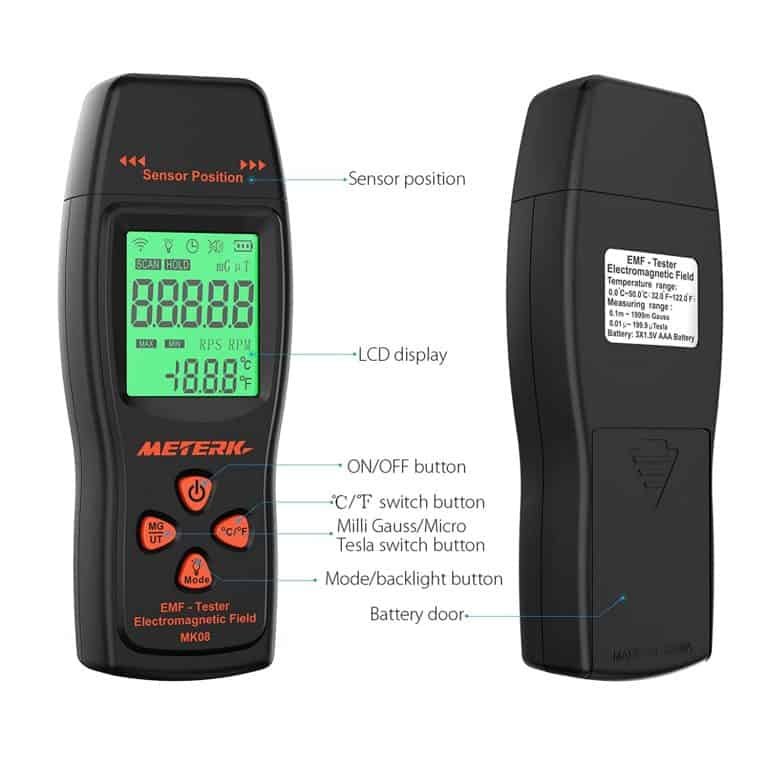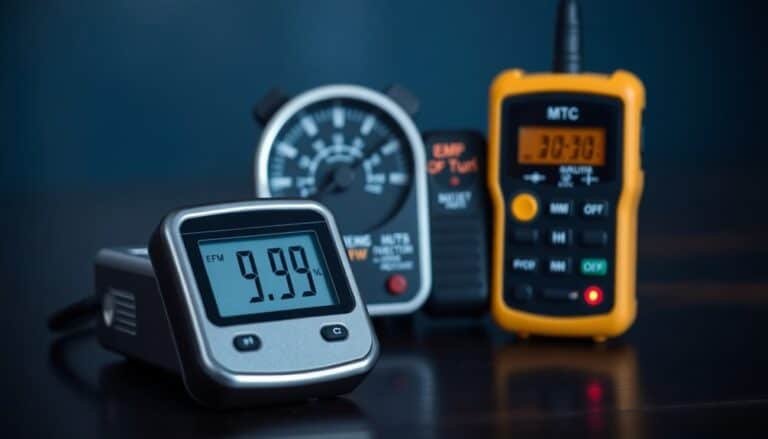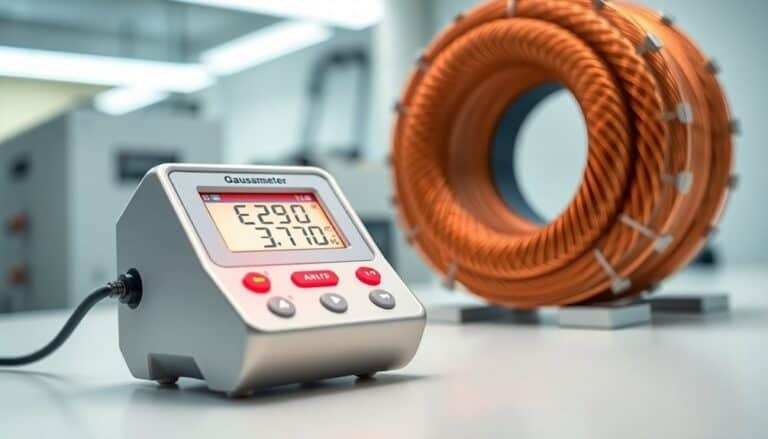Measuring Magnetic Vs Electric Fields (Difference)
Electric fields, measured in volts per meter (V/m), originate from stationary charges and exert forces on positive charges. On the other hand, magnetic fields, measured in teslas (T), result from moving charges or changing electric fields and influence moving charges.
Specialized tools like oscilloscopes measure electric fields, while magnetometers are used for magnetic fields. Delving deeper reveals their diverse applications and theoretical underpinnings.
Disclaimer: As an affiliate, I may collect a share of sales from the links on this page.
Understanding Electric Fields

Electric fields play an essential role in physics, shaping how charged particles interact. Defined as physical fields surrounding electrically charged particles, they describe the forces exerted—attractive or repulsive—on other charges.
Measured in volts per meter (V/m) or newtons per coulomb (N/C), the electric field’s direction points toward the force acting on a positive test charge. According to Coulomb’s Law, these forces vary with the product of charges and their distance apart. Electric fields satisfy the superposition principle, meaning that the total electric field equals the vector sum of individual fields.
Electric field lines demonstrate these forces, originating from positive charges and terminating at negative ones. Ultimately, electric fields drive essential phenomena in atomic, chemical, and electrical contexts.
Understanding Magnetic Fields
Magnetic fields surround magnets and electric currents, forming an essential aspect of electromagnetism. Defined as vector fields, they arise from moving charges or changing electric fields. These fields are dipolar; they’ve no monopoles. You can visualize them as lines of force, emerging from north poles and entering south poles. The strength of a magnetic field diminishes with distance, shown by the density of the field lines. Moving charged particles experience a force that’s perpendicular to both their velocity and the field. This phenomenon is explained by the Lorentz force law, which describes how a charged particle interacts with electric and magnetic fields. Magnetic fields are crucial in various applications, including motors, generators, and medical imaging technologies like MRI.
Measurement Tools for Electric Fields

When measuring electric fields, various specialized tools come into play, each designed to provide accurate and reliable readings.
Oscilloscopes display electric waveforms over time, allowing you to visualize signals in circuits.
Network analyzers, especially VNAs, examine electric fields in RF and microwave applications.
Signal generators create known signals for system testing.
For environmental studies, double probes measure electric fields in the ionosphere.
Additionally, vibrating disc-type field mills assess magnitude and direction, particularly in spacecraft. These tools guarantee precision, focusing on frequency, amplitude, and signal integrity while emphasizing proper calibration and probe selection to enhance measurement reliability. Notably, advanced Rydberg atom-based sensors are emerging as a promising technology for improved electric field measurements.
Measurement Tools for Magnetic Fields
- Guarantee proper magnetic field conditions in manufacturing
- Facilitate groundbreaking scientific discoveries
- Monitor safety standards in medical devices
- Map subsurface structures for resource exploration
Each tool contributes uniquely, enabling you to harness the power of magnetic fields effectively.
Frequency Range Differences

Understanding the frequency range differences is essential for effectively measuring electromagnetic fields. High-frequency fields, ranging from 100 kHz to 300 GHz, include radiofrequency (RF) sources, which can be challenging to measure due to their shorter wavelengths.
In contrast, low-frequency fields, like those from power lines at 60 Hz, are easier to detect. The electromagnetic spectrum encompasses frequencies from below 1 Hz to beyond 10^18 Hz, but measurements usually focus on non-ionizing radiation up to 10 THz.
Different sensors are necessary for each type, as calibration and instrument sensitivity heavily depend on these frequency-specific characteristics.
Physical Characteristics of Electric and Magnetic Fields
Electric and magnetic fields each possess distinct physical characteristics that define their behavior and interactions.
- Electric fields stem from static or moving charges, affecting other charged particles.
- Magnetic fields arise from moving charges, influencing the direction of their motion.
- Field lines for electric fields start and end on charges; magnetic field lines loop around currents.
- Electric fields can exist independently, while magnetic fields require motion for existence.
Understanding these differences helps you grasp how energy and forces interact in your environment, shaping technologies and phenomena you encounter daily.
Applications and Uses of Electric and Magnetic Field Measurements
When measuring electric and magnetic fields, various applications emerge that greatly impact multiple industries.
Electric field measurements are crucial in industrial inspections for high-voltage equipment safety. They guarantee power line safety by monitoring surrounding electric fields and guide electrical system design for efficiency.
Magnetic field measurements play a critical role in geophysical surveys, helping locate minerals and oil. They’re also essential in medical imaging technologies, like MRI machines, which produce detailed body images.
Both measurement types contribute to research and development, improving technology in electronics, telecommunications, and environmental monitoring, guaranteeing safety, efficiency, and capability across various fields.
Theoretical Foundations of Electromagnetism
In the domain of electromagnetism, the foundational concepts are essential for exploring the interactions between electric charges and magnetic fields.
- Electric fields influence charge movement.
- Magnetic fields stem from moving charges.
- Faraday’s Law shows how changing magnetic fields create electric fields.
- Maxwell’s equations unify electricity and magnetism.
These principles form the bedrock of understanding electromagnetism. Electric fields are measured in volts per meter (V/m), while magnetic fields are in teslas (T).
Together, they explain forces on charged particles. Theoretical models, from classical electromagnetism to quantum electrodynamics, deepen our comprehension of these phenomena and their implications.
Interconnection Between Electric and Magnetic Fields
Understanding the interconnected nature of electric and magnetic fields is essential in electromagnetism. Electric and magnetic fields influence each other—when a magnetic field changes, it induces an electric field. Conversely, a moving electric charge generates a magnetic field.
This interplay leads to electromagnetic waves, essential for communication. Maxwell’s equations articulate these interactions, linking electric and magnetic phenomena. You observe these principles in action through devices like transformers and motors.
Additionally, phenomena like the Hall Effect demonstrate the behavior of charges in combined fields. Recognizing these connections enhances your comprehension of both classical electromagnetism and modern applications in technology.
Frequently Asked Questions
How Do Electric and Magnetic Fields Affect Human Health?
Electric and magnetic fields can potentially impact your health. While electric fields are typically safer, some studies link magnetic fields to risks like childhood leukemia. Educating yourself about exposure and safety measures is essential for protection.
Can Electric Fields Block Magnetic Fields or Vice Versa?
Electric fields and magnetic fields dance around each other, weaving their tapestry. You can’t block one with the other; instead, you’ll redirect magnetic fields or shield electric ones using conductive materials for effective protection and safety.
What Are the Environmental Impacts of Electric and Magnetic Fields?
Electric and magnetic fields can affect the environment differently. You’ve got minimal impacts on plant life and marine species from electric fields, while magnetic fields linger and may influence animal behavior. More research is needed for long-term effects.
How Do Electric and Magnetic Fields Interact With Materials?
Electric and magnetic fields interact with materials by inducing magnetization or polarization. You’ll notice paramagnetic materials align with magnetic fields, while diamagnetic ones repel, showcasing their distinct responses to varying field strengths.
What Safety Measures Should Be Considered During Field Measurements?
When taking field measurements, you should guarantee compliance with safety standards, use proper PPE, conduct pre-assessments, maintain equipment, document findings accurately, and establish emergency protocols to protect yourself and your team effectively.
Conclusion
Measuring electric and magnetic fields requires different methods and tools due to their unique properties. For example, a scientist might use an electric field meter to measure voltage near power lines, while a gaussmeter assesses the magnetic field in the same area. Understanding both fields is crucial for applications in communications, medicine, and energy, highlighting their importance in modern technology and safety assessments.






